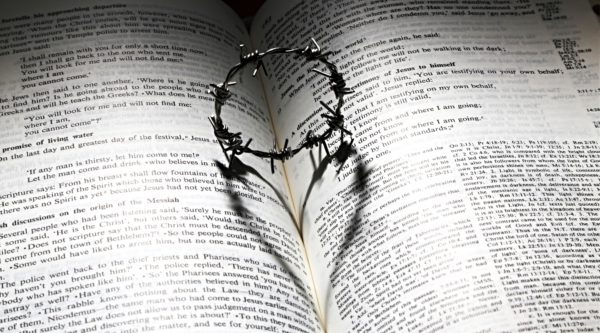
And the Scripture, foreseeing that God would justify the Gentiles by faith, preached the gospel beforehand to Abraham, saying, “In you shall all the nations be blessed” (Galatians 3:8).
In Harper Lee’s novel To Kill a Mockingbird an elderly lady named Mrs. Dubose suffers from a terminal illness and has become addicted to morphine in an attempt to control the pain. As her time nears, she makes the difficult decision to wean herself from the painkiller, wanting to leave this world “beholden to nothing or nobody.” When Mrs. Dubose passes away, Atticus Finch, father to the main character Scout and her brother Jem, says of Mrs. Dubose to his two children:
“I wanted you to see what real courage is, instead of getting the idea that courage is a man with a gun in his hand. It’s when you know you’re licked before you begin, but you begin anyway and see it through no matter what.”
These words pay homage to the courage Mrs. Dubose exercised in dying with dignity, on her own terms. And in that simple statement, Harper Lee foreshadows the courage that Atticus himself will have to exercise later in the novel while defending an innocent man he knows will be convicted, no matter how hard Atticus fights for the truth. Atticus will take the case, and he will see it through, not because he thinks he can win, but because he knows it is the right thing to do.
Foreshadowing is a literary device in which an author gives an advance sign or warning to give indication of a significant future event in the work. The earlier episode shadows that event in the same way our bodies cast shadows when they block sunlight, or our hands cast shadows when we use a light to make shadow puppets. These shadows are outlines of the concrete reality. They correlate exactly to the original object, although they aren’t as detailed. We see this in shadow art, or in the little silhouette pictures many of us have of our children. As soon as our eyes fall upon that simple profile, we see our son or daughter in every turn of the image.
The authors of the Old Testament use many such images to foreshadow the greater truth of Christ, who does not appear in this world until centuries after these authors were writing. There were also historic people, and events recorded in the Old Testament, which are true shadows of the coming Christ. The authors of the New Testament uncover this reality for us in their writings. By doing this, they encourage us to look beyond the shadows and see the greater truth they depict. Moses, the deliverer from Egyptian bondage and the mediator of the old covenant, was a shadow of Jesus delivering His people from the greater bondage of sin and mediating the better covenant of grace through His blood (Hebrews 3:1–6 and 9:12–15). The sacrificial system of worship described throughout the Old Testament was a shadow of the one true sacrifice of Jesus on the cross (Hebrews 10:1–10). David, the great king of Israel, shadowed the greater King of Kings and Lord of Lords (Revelation 19:16). The high priest of Israel was a shadow of the Great High Priest who continually intercedes for us with the Father (Hebrews 8:1–7). Each of these people or events shadowed a unique characteristic of the Christ who was to come. To only see these shadows without seeing the reality they foreshadow is to miss the true message of the Old Testament: the writer to the Hebrews tells us that the Old Testament was a “shadow of the good things to come instead of the true form of those realities” (Hebrews 10:1).
It is with the God-given eyes of faith that we see this reality in the shadows. This is why so many of the Jewish leaders rejected Jesus as their Messiah. They did not see Him in the message of their scriptures, and so they disregarded Him. But those of faith did see Christ in the Old Testament. Jesus says in John’s gospel that Abraham, who lived 2,000 years before Jesus, saw the day of Jesus’ coming and He rejoiced in that day (John 8:56). Abraham saw the day of Jesus in the shadow picture given when God promised Abraham that the nations of the world would be blessed in him (Genesis 12:3). And Abraham believed that promise. The Apostle Paul tells us in his letter to the Galatians, that this covenant promise to Abraham was, in its deeper meaning, God preaching the gospel of Christ to Abraham.
And the Scripture, foreseeing that God would justify the Gentiles by faith, preached the gospel beforehand to Abraham, saying, “In you shall all the nations be blessed” (Galatians 3:8).
It is through Christ that the blessings of Abraham’s covenant flow, not only to Abraham, but to the world.
But, not only do the New Testament writers want us to see Christ in the Old, they want us to see that the Old was the Testament of Christ, just as much as the New is. They want us to see that these pictures of Christ are not just isolated images sprinkled throughout the otherwise unrelated story of the Old Testament. The story of the Old is itself the shadow story of the New. It is the message of God’s redeeming love and forgiveness through Christ foreshadowed through the Old Testament narrative. The Apostle Paul says in his letter to the Colossians: “Therefore let no one pass judgment on you in questions of food and drink, or with regard to a festival or a new moon or a Sabbath. 17 These are a shadow of the things to come, but the substance is Christ” (Colossians 2:16–17).
And, as the resurrected Jesus walks on the road to Emmaus teaching two disciples, He admonishes them to understand that all the Old Testament scriptures were truly about Him, and His story of redemption:
And he said to them, “O foolish ones, and slow of heart to believe all that the prophets have spoken! 26 Was it not necessary that the Christ should suffer these things and enter into his glory?” 27 And beginning with Moses and all the Prophets, he interpreted to them in all the Scriptures the things concerning himself (Luke 24:25–27).
We are encouraged by Jesus and the New Testament writers to read and understand the Old Testament with Christ as its substance. This may engender a significant paradigm shift for many of us, changing our perception of the Old Testament. No longer can we be content to say there is a stark difference between the God of the Old Testament and the God of the New. No longer can we look at the Old Testament bible stories as antiquated anecdotes, not having much to do with us, except as modern-day object lessons or good moral examples. No longer can we say that the promises and prescriptions of the Old Testament were something for a different people in a different place and time. There is a unity between the Testaments, just as there is a unity between the shadow and the reality which casts that shadow. And just as Jesus admonished His disciples on the road to Emmaus to see that unity of the Testaments in Him, so He admonishes us to look for the deeper understanding of the events of the Old Testament and to see Him.
Last month I wrote about one of those shadowy pictures: God clothing Adam and Eve with an alien righteousness after they sinned in the Garden. In the eyes of God, the skins of slain animals were the only sufficient covering for the wrong they had committed against Him. These animal coverings were an early shadow of the grace of God in the work of Christ, as He is the One who ultimately covers our sin with the robes of His beautiful perfect sinlessness.
Do we see the Old Testament as the penmanship of God’s providence drawing the shadow pictures of Christ through time? Are our eyes open to see that the Bible is the story of Christ from first page to last? Like the silhouette pictures of our children, do we see Jesus at every turn of the page?
But when Christ appeared as a high priest of the good things that have come, then through the greater and more perfect tent (not made with hands, that is, not of this creation) 12 he entered once for all into the holy places, not by means of the blood of goats and calves but by means of his own blood, thus securing an eternal redemption (Hebrews 9:11–12).













